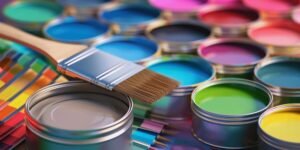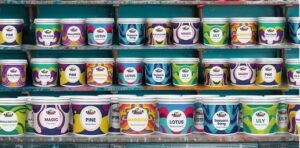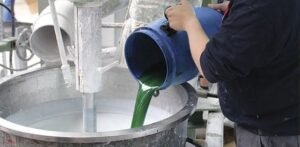Introduction to Paint Production
The paint production process is a multi
faceted and essential activity that plays a critical role in a variety of sectors, including construction, automotive, and consumer goods. Understanding this process offers insights into how raw materials are transformed into the vibrant and functional products used in everyday life, such as mithila home paints. Paint primarily serves to enhance aesthetic appeal, provide protective coatings, and improve durability against environmental factors.
The composition of paint generally includes pigments, binders, solvents, and additives. Pigments are responsible for the color and opacity, binders ensure adhesion and durability, solvents affect the paint’s viscosity and ease of application, while additives enhance specific characteristics like drying time and mold resistance. This balanced combination results in various paint products tailored for different applications, such as the water-based or oil-based options found in mithila home paints.
The paint production process can be broadly categorized into several key stages. Initially, raw materials are sourced, which involves selecting quality components necessary for producing high-performing paint. These raw materials then undergo processing where they are blended, milled, and refined to achieve the desired texture and consistency. Following this, the mixture is subjected to rigorous quality control measures to ensure compliance with industry standards. Finally, the finished paint products are packaged and distributed for market use.
This systematic approach to paint manufacturing not only facilitates the production of quality products but also drives innovation in paint technology. With advancements in formulations and production techniques, industries have access to increasingly refined products, such as eco-friendly mithila home paints, catering to both consumer preferences and environmental concerns. Understanding the intricacies of the paint production process is essential for anyone involved in the manufacturing or application of paint products.
Raw Materials Used in Paint Manufacturing
The paint manufacturing process relies heavily on a variety of raw materials that each serve critical functions in determining the performance and aesthetic quality of the final product. One of the primary components is pigments, which provide the color and opacity to the paint. These pigments may be organic or inorganic, and their selection impacts not only the visual appeal but also the durability and lightfastness of the paint. High-quality pigments are essential for products like mithila home paints, as they ensure vibrant colors that resist fading over time.
Binders represent another essential element in paint formulation. They are responsible for adhering the pigment particles to the substrate and providing cohesion to the dried film. Common types of binders include acrylics, alkyds, and polyurethanes. The choice of binder directly influences properties such as gloss, adhesion, and flexibility. In high-quality products such as mithila home paints, the binders are selected to optimize the durability and application ease of the paint, making them suitable for various surfaces and conditions.
Solvents, or carriers, play a crucial role in the paint’s application properties. They dissolve the binder and help to disperse the pigments, ensuring a smooth application. While traditional solvents might include mineral spirits and turpentine, there is a growing trend toward water-based formulations that are more environmentally friendly and safer for indoor use. The effectiveness of mithila home paints, for example, can be attributed to the careful selection of solvents that enhance the user experience without compromising on quality.
Lastly, additives are utilized to enhance specific characteristics of paint. These may include substances that improve flow, drying time, antifungal properties, or texture. Properly formulated additives can significantly impact the performance of the paint, meeting the nuanced demands of consumers. Understanding the various raw materials used in paint manufacturing allows for better-informed choices when selecting products such as mithila home paints, ensuring optimal results for various applications.

The Grinding Process
The grinding process is a pivotal stage in the production of paint, particularly for ensuring the right particle size of pigments. Achieving an optimal particle size facilitates uniform dispersion, which directly affects the paint’s color strength, consistency, and overall performance. Various grinding techniques are employed, with each method tailored to specific pigments and desired outcomes. The most commonly used equipment in this phase includes ball mills and bead mills.
Ball mills utilize a rotating cylinder filled with balls made of hard materials to grind pigments into a fine powder. The rotation causes the balls to collide with the pigment particles, which leads to size reduction. The length of time and speed of rotation can be adjusted depending on the desired fineness of the pigment. This method is widely applicable and can process larger volumes, making it suitable for manufacturers of mithila home paints that require consistent quality.
On the other hand, bead mills operate on a similar principle but use smaller beads that agitate the pigment mixture, providing a more intensive grinding action. This technique is particularly effective for producing fine dispersions and is often preferred for high-performance paints where uniformity is essential. Both ball mills and bead mills contribute substantially to the efficiency of the paint production process, ensuring that the pigments achieve the necessary fineness for optimal dispersion within the paint matrix.
Moreover, the significance of the grinding process extends beyond achieving a desired particle size. It plays a crucial role in determining the rheological properties and flow characteristics of the final product. An even distribution of pigment particles ensures not only aesthetic quality but also durability and performance of the paint. Therefore, careful attention to the grinding stage is paramount for manufacturers aiming to meet the high standards expected of mithila home paints.
Mixing and Formulation of Paint
The mixing and formulation of paint is a crucial phase in the paint production process where various raw materials are combined to develop a uniform and functional product. This stage typically involves the careful integration of pigments, resins, solvents, and additives, with the objective of achieving the desired consistency and performance characteristics. For producing high-quality mithila home paints, it is vital to ensure that all components are mixed effectively to obtain a smooth and even texture.
There are various mixing methods employed in the formulation of paint, including batch mixing and continuous mixing. Batch mixing is often used for smaller quantities, allowing for more precise control over the formulation. In contrast, continuous mixing is advantageous for large-scale production, as it guarantees a consistent supply of materials and enhanced efficiency. Whatever method is chosen, it is crucial to monitor the mixing speed and duration to avoid issues such as separation or sedimentation, which can compromise the quality of the final product.
Additionally, the formulation of paint may require adjustments to meet specific requirements such as viscosity and color. Viscosity is particularly important as it determines the application characteristics of the paint. Various thickeners or flow agents may be added to achieve the desired formulation. Color matching also plays an essential role in creating mithila home paints, where achieving the correct hue in relation to customer specifications is imperative. This often involves using spectrophotometers and other techniques for precise color formulation.
Quality control is paramount during the mixing and formulation processes, as it ensures that the paint produced meets industry standards and customer expectations. Regular testing for parameters such as viscosity, color consistency, and drying times is essential throughout production. By adhering to meticulous quality control practices, manufacturers can deliver reliable and high-performance mithila home paints that cater to the diverse needs of consumers.

Stabilization and Quality Control
The stabilization of paint is a critical aspect of the production process that ensures a product like mithila home paints maintains its intended properties over time. Throughout the manufacturing cycle, various methods are employed to mitigate factors that may compromise the stability of the paint. Emulsifiers and stabilizers are integral in enhancing the dispersion of pigments and additives, promoting uniformity in color and texture. This stabilization is crucial, as it directly affects the paint’s performance, longevity, and user satisfaction.
Quality control measures are essential in assessing the stability of mithila home paints. Standardized testing protocols are instituted to evaluate multiple parameters, such as color accuracy, consistency, viscosity, and drying time. These tests ensure that the paint achieves the desired appearance and functionality, thus fulfilling consumer expectations. For color accuracy, spectrophotometric analysis is frequently conducted to guarantee the paint matches the specified color formula, a non-negotiable requirement in the decorative paints sector.
Furthermore, storage tests play a critical role in assessing the shelf-life of the paint. Samples are subjected to varying temperatures and conditions to simulate long-term storage scenarios. This practice not only helps anticipate potential degradation but also assists in identifying any sediment formation or changes in viscosity that may occur over time. The quality control team conducts these assessments periodically throughout the production cycle to ensure that every batch of mithila home paints adheres to the highest industry standards.
Overall, the stabilization and quality control measures are pivotal in the paint manufacturing process. Through rigorous testing and adherence to protocols, manufacturers can provide consumers with products that are reliable, durable, and of exceptional quality. These practices guarantee that mithila home paints consistently meet market demands, enhancing customer satisfaction and brand reputation.

Packaging and Labeling
The packaging and labeling of paint products play a critical role in the overall production process, serving functions that extend beyond mere containment. For high-quality products like Mithila home paints, the choice of packaging materials is pivotal. Commonly used materials include metal cans, plastic containers, and glass jars, each offering distinct advantages in terms of protection, durability, and marketability. Metal cans, for instance, provide an excellent barrier against moisture and external contaminants, ensuring that the paint remains in optimal condition until it reaches the consumer. On the other hand, plastic containers are lightweight and less prone to breakage, making them a popular choice in the retail sector.
Labeling is equally significant, as it furnishes essential information about the product to the consumer. Each container of Mithila home paints must display clearly defined labeling that includes product specifications, usage instructions, safety warnings, and compliance with industry standards. Proper labeling not only enhances consumer safety but also aids in informing customers about the unique qualities of the paint, such as its washability, finish type, and environmental impact. For instance, highlighting eco-friendly components can not only fulfill regulatory requirements but also attract environmentally conscious consumers.
Moreover, the impact of packaging on marketing and distribution cannot be overstated. Eye-catching designs and effective labeling can differentiate Mithila home paints from competitors on store shelves, thereby influencing purchasing decisions. Accessibility and functionality in packaging also facilitate the distribution process, ensuring that the product can be transported efficiently to retailers without compromising quality. Ultimately, thoughtful consideration of packaging and labeling is crucial, as it significantly enhances both the consumer experience and the product’s marketability.

Environmental Considerations in Paint Production
The paint production process significantly affects the environment, necessitating a thorough examination of various factors, including waste management, emissions, and the implementation of sustainable practices. Traditional paint manufacturing often involves the use of volatile organic compounds (VOCs), which can lead to air pollution and pose health risks. Consequently, the industry has begun to shift towards eco-friendly solutions that prioritize environmental safety and sustainability, exemplified by brands such as Mithila home paints.
One of the key environmental challenges in paint production is waste generation. During the manufacturing process, a considerable amount of raw materials can become waste, resulting in the need for effective waste management strategies. Recycling and reusing materials are critical steps for manufacturers to mitigate their ecological impact. For instance, by reprocessing unused paint or utilizing containers made from recycled materials, companies can drastically reduce their waste outputs and contribute to a more sustainable future. This proactive approach not only aligns with global emissions reduction goals but also enhances the brand image of companies that prioritize environmental responsibility.
In addition to waste management, the transition towards sustainable practices encompasses the selection of raw materials. The industry is increasingly adopting alternative ingredients that reduce harmful emissions and ecological footprints. Biomass-based materials and water-based emulsions are prime examples of such alternatives, demonstrating that effective and eco-friendly paints are achievable without compromising quality. Innovations in production techniques, such as cold-process methods which cut down energy consumption, are also paving the way for greener solutions. It is evident that embracing sustainable practices is not merely a trend; it is an essential aspect of modern paint production that ensures both the preservation of the environment and the production of high-quality products like Mithila home paints.
Technological Advances in Paint Manufacturing
The paint manufacturing industry has undergone significant transformations in recent years, driven by the arrival of advanced technologies aimed at improving efficiency, quality, and environmental compliance. Automation has become a cornerstone of modern paint production, streamlining operations and reducing the potential for human error. Automated mixing and blending systems ensure a consistent formulation of products like mithila home paints, optimizing production speed while maintaining high quality standards.
Digital color matching technologies represent another groundbreaking advancement in the paint manufacturing domain. These tools allow for precise identification and replication of colors, which is crucial for manufacturers to meet custom color specifications. Utilizing sophisticated software and scanning devices, paint producers can achieve an exact match to customer requests or existing painted surfaces. This level of accuracy not only enhances customer satisfaction but also reduces material waste, contributing positively to environmental efforts.
Additionally, advancements in the formulation of paints have led to the development of eco-friendly alternatives that comply with increasingly stringent environmental regulations. Water-based formulations and low-VOC (volatile organic compounds) options are becoming prevalent, providing consumers with safer choices for home interiors. Mithila home paints, for instance, have benefited from these innovations by offering products that are not only aesthetically pleasing but also environmentally responsible.
Modern quality control methodologies are essential to maintaining the integrity of the production process. The implementation of real-time monitoring systems allows manufacturers to assess the properties of their paints at various stages. This vigilance ensures that products like mithila home paints meet consistent quality parameters, ultimately leading to superior end products. As technological innovations continue to evolve, the paint manufacturing sector is set to become even more efficient while adhering to sustainable practices.

Conclusion and Future Trends in Paint Production
Throughout this blog post, we have explored the intricate paint production process, starting from the selection of raw materials to the formulation and packaging of the final product. A notable focus was placed on the evolution and innovative approaches shaping the paint industry, which reflects a broader push towards enhanced performance and sustainability. With the rise of environmentally friendly solutions, such as mithila home paints, the market is witnessing a paradigm shift. Consumers are increasingly seeking options that not only provide aesthetic appeal but also contribute to the well-being of the environment.
As we consider future trends in the paint production sector, it is essential to recognize the growing demand for high-performance coatings that ensure durability and resistance. This evolution is being driven by technological advancements and new formulations that meet the ever-changing needs of consumers. For instance, the development of eco-friendly products is expected to accelerate, with companies focusing on solvent-free or low-VOC (volatile organic compounds) formulations. Mithila home paints serve as a prime example of this trend, combining sustainability with superior quality, thereby appealing to modern homeowners.
Moreover, we anticipate increased automation and digitalization within the manufacturing processes. This transition is likely to enhance efficiency, reduce costs, and maintain quality control. The integration of smart technology will facilitate real-time monitoring and adjustments, ensuring optimal production outcomes. Additionally, customization in paint production is expected to gain traction, allowing consumers to create unique color mixes and textures tailored to their individual preferences.
In conclusion, the paint production industry stands at the intersection of innovation, sustainability, and consumer demand. With ongoing advancements and a commitment to environmental stewardship, the future of paint manufacturing looks promising. As we embrace these changes, the significance of products such as mithila home paints will undoubtedly grow, reflecting not only aesthetic value but also a dedication to preserving our planet for future generations.

